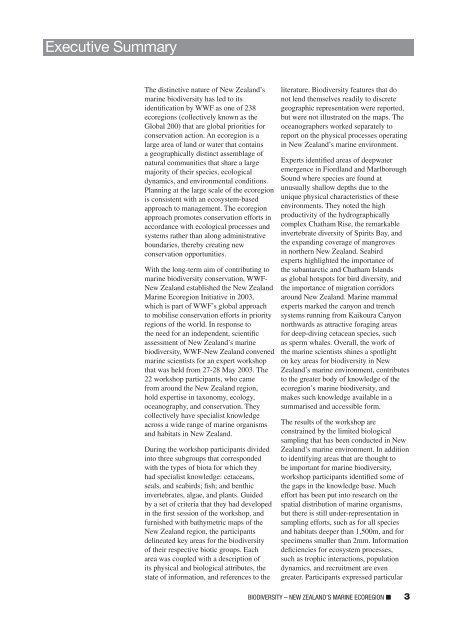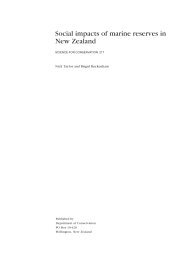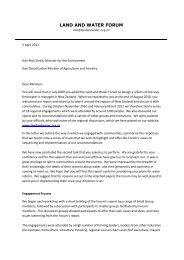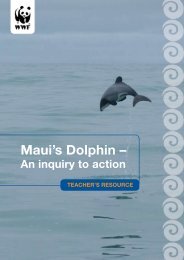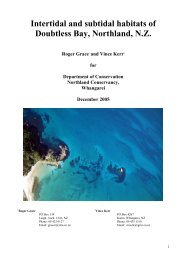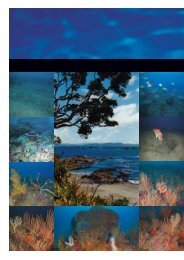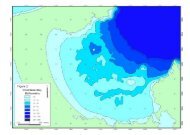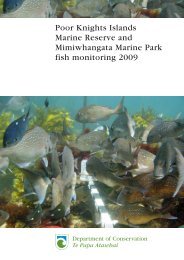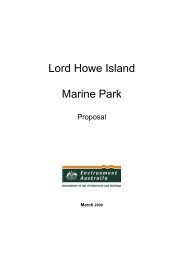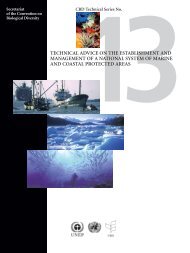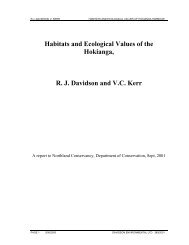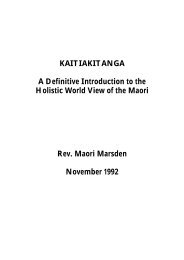WWF Shining a spotlight on the biodiversity of ... - MarineNZ.org.nz
WWF Shining a spotlight on the biodiversity of ... - MarineNZ.org.nz
WWF Shining a spotlight on the biodiversity of ... - MarineNZ.org.nz
You also want an ePaper? Increase the reach of your titles
YUMPU automatically turns print PDFs into web optimized ePapers that Google loves.
Executive Summary<br />
The distinctive nature <strong>of</strong> New Zealand’s<br />
marine <strong>biodiversity</strong> has led to its<br />
identificati<strong>on</strong> by <str<strong>on</strong>g>WWF</str<strong>on</strong>g> as <strong>on</strong>e <strong>of</strong> 238<br />
ecoregi<strong>on</strong>s (collectively known as <strong>the</strong><br />
Global 200) that are global priorities for<br />
c<strong>on</strong>servati<strong>on</strong> acti<strong>on</strong>. An ecoregi<strong>on</strong> is a<br />
large area <strong>of</strong> land or water that c<strong>on</strong>tains<br />
a geographically distinct assemblage <strong>of</strong><br />
natural communities that share a large<br />
majority <strong>of</strong> <strong>the</strong>ir species, ecological<br />
dynamics, and envir<strong>on</strong>mental c<strong>on</strong>diti<strong>on</strong>s.<br />
Planning at <strong>the</strong> large scale <strong>of</strong> <strong>the</strong> ecoregi<strong>on</strong><br />
is c<strong>on</strong>sistent with an ecosystem-based<br />
approach to management. The ecoregi<strong>on</strong><br />
approach promotes c<strong>on</strong>servati<strong>on</strong> efforts in<br />
accordance with ecological processes and<br />
systems ra<strong>the</strong>r than al<strong>on</strong>g administrative<br />
boundaries, <strong>the</strong>reby creating new<br />
c<strong>on</strong>servati<strong>on</strong> opportunities.<br />
With <strong>the</strong> l<strong>on</strong>g-term aim <strong>of</strong> c<strong>on</strong>tributing to<br />
marine <strong>biodiversity</strong> c<strong>on</strong>servati<strong>on</strong>, <str<strong>on</strong>g>WWF</str<strong>on</strong>g>-<br />
New Zealand established <strong>the</strong> New Zealand<br />
Marine Ecoregi<strong>on</strong> Initiative in 2003,<br />
which is part <strong>of</strong> <str<strong>on</strong>g>WWF</str<strong>on</strong>g>’s global approach<br />
to mobilise c<strong>on</strong>servati<strong>on</strong> efforts in priority<br />
regi<strong>on</strong>s <strong>of</strong> <strong>the</strong> world. In resp<strong>on</strong>se to<br />
<strong>the</strong> need for an independent, scientific<br />
assessment <strong>of</strong> New Zealand’s marine<br />
<strong>biodiversity</strong>, <str<strong>on</strong>g>WWF</str<strong>on</strong>g>-New Zealand c<strong>on</strong>vened<br />
marine scientists for an expert workshop<br />
that was held from 27-28 May 2003. The<br />
22 workshop participants, who came<br />
from around <strong>the</strong> New Zealand regi<strong>on</strong>,<br />
hold expertise in tax<strong>on</strong>omy, ecology,<br />
oceanography, and c<strong>on</strong>servati<strong>on</strong>. They<br />
collectively have specialist knowledge<br />
across a wide range <strong>of</strong> marine <strong>org</strong>anisms<br />
and habitats in New Zealand.<br />
During <strong>the</strong> workshop participants divided<br />
into three subgroups that corresp<strong>on</strong>ded<br />
with <strong>the</strong> types <strong>of</strong> biota for which <strong>the</strong>y<br />
had specialist knowledge: cetaceans,<br />
seals, and seabirds; fish; and benthic<br />
invertebrates, algae, and plants. Guided<br />
by a set <strong>of</strong> criteria that <strong>the</strong>y had developed<br />
in <strong>the</strong> first sessi<strong>on</strong> <strong>of</strong> <strong>the</strong> workshop, and<br />
furnished with bathymetric maps <strong>of</strong> <strong>the</strong><br />
New Zealand regi<strong>on</strong>, <strong>the</strong> participants<br />
delineated key areas for <strong>the</strong> <strong>biodiversity</strong><br />
<strong>of</strong> <strong>the</strong>ir respective biotic groups. Each<br />
area was coupled with a descripti<strong>on</strong> <strong>of</strong><br />
its physical and biological attributes, <strong>the</strong><br />
state <strong>of</strong> informati<strong>on</strong>, and references to <strong>the</strong><br />
literature. Biodiversity features that do<br />
not lend <strong>the</strong>mselves readily to discrete<br />
geographic representati<strong>on</strong> were reported,<br />
but were not illustrated <strong>on</strong> <strong>the</strong> maps. The<br />
oceanographers worked separately to<br />
report <strong>on</strong> <strong>the</strong> physical processes operating<br />
in New Zealand’s marine envir<strong>on</strong>ment.<br />
Experts identified areas <strong>of</strong> deepwater<br />
emergence in Fiordland and Marlborough<br />
Sound where species are found at<br />
unusually shallow depths due to <strong>the</strong><br />
unique physical characteristics <strong>of</strong> <strong>the</strong>se<br />
envir<strong>on</strong>ments. They noted <strong>the</strong> high<br />
productivity <strong>of</strong> <strong>the</strong> hydrographically<br />
complex Chatham Rise, <strong>the</strong> remarkable<br />
invertebrate diversity <strong>of</strong> Spirits Bay, and<br />
<strong>the</strong> expanding coverage <strong>of</strong> mangroves<br />
in nor<strong>the</strong>rn New Zealand. Seabird<br />
experts highlighted <strong>the</strong> importance <strong>of</strong><br />
<strong>the</strong> subantarctic and Chatham Islands<br />
as global hotspots for bird diversity, and<br />
<strong>the</strong> importance <strong>of</strong> migrati<strong>on</strong> corridors<br />
around New Zealand. Marine mammal<br />
experts marked <strong>the</strong> cany<strong>on</strong> and trench<br />
systems running from Kaikoura Cany<strong>on</strong><br />
northwards as attractive foraging areas<br />
for deep-diving cetacean species, such<br />
as sperm whales. Overall, <strong>the</strong> work <strong>of</strong><br />
<strong>the</strong> marine scientists shines a <str<strong>on</strong>g>spotlight</str<strong>on</strong>g><br />
<strong>on</strong> key areas for <strong>biodiversity</strong> in New<br />
Zealand’s marine envir<strong>on</strong>ment, c<strong>on</strong>tributes<br />
to <strong>the</strong> greater body <strong>of</strong> knowledge <strong>of</strong> <strong>the</strong><br />
ecoregi<strong>on</strong>’s marine <strong>biodiversity</strong>, and<br />
makes such knowledge available in a<br />
summarised and accessible form.<br />
The results <strong>of</strong> <strong>the</strong> workshop are<br />
c<strong>on</strong>strained by <strong>the</strong> limited biological<br />
sampling that has been c<strong>on</strong>ducted in New<br />
Zealand’s marine envir<strong>on</strong>ment. In additi<strong>on</strong><br />
to identifying areas that are thought to<br />
be important for marine <strong>biodiversity</strong>,<br />
workshop participants identified some <strong>of</strong><br />
<strong>the</strong> gaps in <strong>the</strong> knowledge base. Much<br />
effort has been put into research <strong>on</strong> <strong>the</strong><br />
spatial distributi<strong>on</strong> <strong>of</strong> marine <strong>org</strong>anisms,<br />
but <strong>the</strong>re is still under-representati<strong>on</strong> in<br />
sampling efforts, such as for all species<br />
and habitats deeper than 1,500m, and for<br />
specimens smaller than 2mm. Informati<strong>on</strong><br />
deficiencies for ecosystem processes,<br />
such as trophic interacti<strong>on</strong>s, populati<strong>on</strong><br />
dynamics, and recruitment are even<br />
greater. Participants expressed particular<br />
BIODIVERSITY – NEW ZEALAND’S MARINE ECOREGION ■ 3


